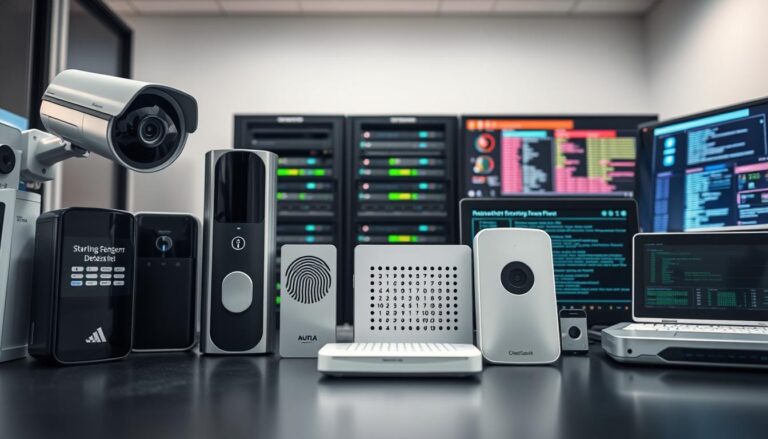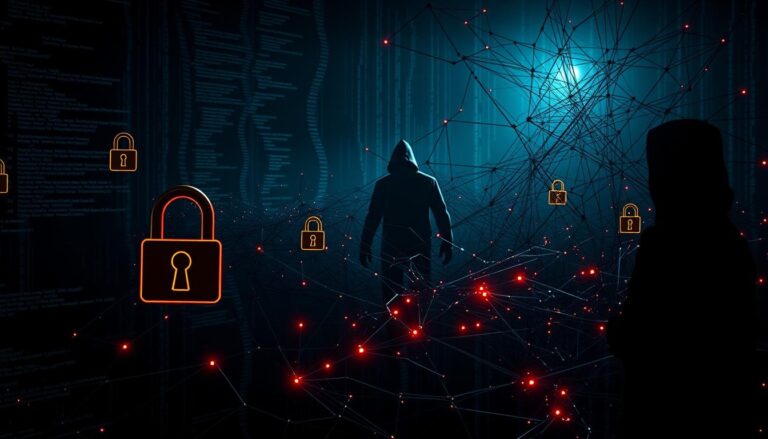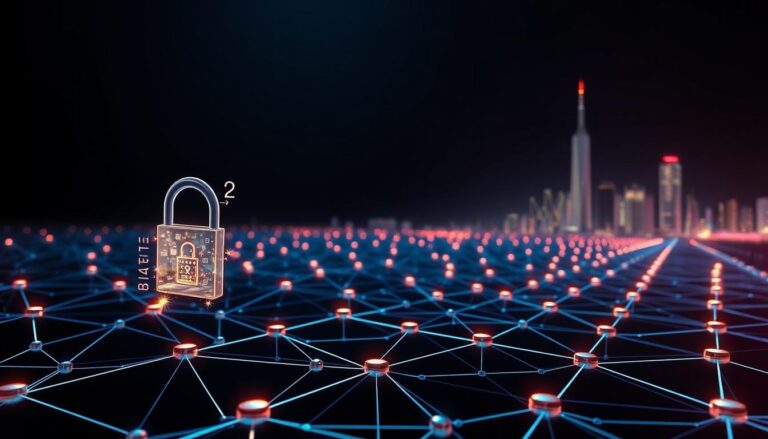How AI is Changing the Future of Cybersecurity
AI and rapid innovation are reshaping how we defend systems. Workshops from CLTC and WEF warn that by 2030 the mindset will shift from fortress defense to resilience and recovery.
Threats will keep evolving. Analysts see modular malware, MaaS/RaaS offerings, and AI-driven social engineering that scale attacks fast. At the same time, new detection tools promise faster response and better protection for sensitive data.
AI acts as a double-edged tool: it speeds detection and empowers attackers. Compute, model work, and national investments will decide who leads in defense. Improved governance in the U.S., plus global policy shifts, can speed safer practices across the world.
Integrity and provenance may matter more than secrecy when synthetic media and disinformation erode trust. Leaders must map the expanding attack surface—from edge gear to core routers—and align investment with business risk in the years ahead.
Key Takeaways
- Shift to resilience: Defense will emphasize recovery and continuity.
- Persistent threats: Modular malware and AI-powered scams will endure.
- AI dual-use: It helps defenders and attackers; balance is crucial.
- Wider surface: Edge devices and network gear demand attention.
- Governance matters: Public-private action and policy shape outcomes.
Executive brief: Where AI meets a shifting threat surface
AI is shifting how defenders and attackers scope risk across networks and devices. This brief equips organizations and analysts with an approach for near-term work and the 2030 horizon. It focuses on practical steps to manage widening risk this year and beyond.
User intent and scope of this trend analysis
Readers want clear, actionable synthesis—not hype. Expect prioritized next steps, real examples (MaaS, ArcaneDoor router access), and verdicts tied to data from CLTC, WEF, and field analysts.
- Scope: persistent malware/RaaS/MaaS, AI-enabled social engineering, APT infrastructure tradecraft, AiTM MFA bypass, and edge-device compromise.
- Policy context: U.S. governance changes (National Cyber Director, SEC rules) shape board-level decisions and compliance expectations.
| Signal | Implication | Near-term action |
|---|---|---|
| Modular malware & MaaS | Faster scale, recurring campaigns | Harden supply chains; monitor threat intel |
| Router/VPN initial access | Network appliances as primary surface | Patch appliances; segment networks |
| AI-driven synthetic content | Trust erosion; incident complexity | Improve provenance controls; verify sources |
Methods: cross-referenced scenario work, commercial field research, and policy intelligence to give decision-grade guidance. Expect iterative reviews as models, attacks, and controls change year to year.
The Future of Cybersecurity: Key forces reshaping risk and resilience
Resilience, not high walls, will define strong security strategies in coming years.
Assume compromise. Organizations should minimize blast radius, segment systems, and speed recovery. Align business continuity with technical controls and set clear, time‑bound milestones for recovery objectives.
Integrity and provenance gain priority
AI-generated content forces a shift from secrecy to verifiable information. Logging, attestation, and provenance tools become core controls.
Practical moves: add tamper-evident logs, content attestations, and strict source verification for critical communications.
Uneven progress across the world
Not every industry or country will advance at the same pace. Capability gaps, varied rules, and different investment levels create asymmetries in exposure to threats and attacks.
- Education: teaching security basics in primary schools and upskilling workers builds long-term resilience.
- Government role: intelligence-led collaboration and focused programs lift critical sectors where downtime risks life and safety.
- Technology complexity: multi-cloud, edge, and AI pipelines require updated risk models and secure-by-design checks.
| Force | Impact | Near-term action |
|---|---|---|
| Resilience shift | Faster recovery, reduced impact | Define RTO/RPO; practice incident drills |
| Information provenance | Trust regained; fewer false leads | Implement attestations and tamper-proof logging |
| Uneven global progress | Asymmetric risk and attack surfaces | Prioritize supply-chain checks and cross-border coordination |
AI’s dual-use reality: Accelerating defense and supercharging attacks
Machine learning is compressing months of work into minutes for defenders and attackers alike. This shift brings real gains and real risks. Teams must balance rapid detection with new categories of threat introduced by models and pipelines.
Defensive advantages
Models and learning detect deviations from behavioral baselines and enrich telemetry. That reduces dwell time and improves incident response speed.
Predictive analytics forecast vulnerabilities and help prioritize patches so scarce resources protect the most critical systems first.
NLP filters screen email and chat for malicious content and grow more precise with user feedback, cutting false positives over time.
Offensive acceleration
Synthetic media and automated tooling lower skill barriers. Less-skilled actors can scale convincing scams and attacks with fewer artifacts.
Example: phishing-as-a-service kits like Mamba capture tokens to bypass MFA and proxy sessions to hijack accounts.
Compute as strategic asset
Compute capacity shapes who can test, validate, and secure models at scale. Treating compute as infrastructure narrows national and enterprise capability gaps.
Secure MLOps, stronger model governance, and clear evaluation criteria for AI tools must become standard practice.
| Area | Benefit | Near-term action |
|---|---|---|
| Detection & response | Faster triage; lower dwell time | Deploy behavioral baselines; tune models |
| Predictive analytics | Prioritized remediation | Integrate vuln forecasts into patch cycles |
| Model supply chain | New vulnerability class | Adopt secure MLOps and model testing |
Persistent and emerging threats shaping the next few years
Adversaries now combine off-the-shelf tooling with targeted tradecraft to scale impact quickly. Modular malware and RaaS/MaaS amplify speed and make attacks cheaper to run.
Modular malware and service models
Toolkits let actors swap payloads and adapt to defenses fast. That accelerates monetization and shortens response windows.
Example: Redline Stealer harvests credentials and payment data, then fuels fraud and business email compromise when sold on criminal markets.
AI-enhanced social engineering
Generative models personalize lures, mix benign content with malicious links, and trick well-trained users. Human factors remain the weak link despite technical controls.
Proximity and infrastructure targeting
Some APTs target local networks and devices. APT28’s nearest-neighbor Wi‑Fi tactics show how attackers bypass perimeter defenses by exploiting local proximity.
AiTM and token theft
“Session interception now yields long-lived access when tokens and cookies are captured.”
Kits like Mamba standardize token capture and make token theft routine. Stolen cookies often evade legacy detection, so stronger session revocation and continuous authentication are critical.
| Threat | Impact | Recommended action |
|---|---|---|
| Modular malware / RaaS | Rapid, repeatable attacks | Harden endpoints; monitor marketplaces |
| AI-driven social engineering | Higher phishing success | Train users; use contextual filters |
| AiTM / token theft | Persistent access via sessions | Revoke tokens; add continuous signals |
| Proximity-based APT tradecraft | Bypasses perimeter controls | Segment networks; secure Wi‑Fi |
Expanding attack surface: From endpoints to edge and critical infrastructure
Network appliances have quietly become high-value targets for persistent intrusions. Routers, firewalls, and VPN gateways now sit squarely on the attack surface because patch cycles lag and configuration drift creates exploitable vulnerabilities.
Routers, firewalls, VPNs as initial access points
Control of a perimeter device gives attackers broad access to traffic and credentials. They can monitor, reroute, or stage adversary-in-the-middle attacks that evade endpoint-only detection.
Internet-exposed management interfaces and weak segmentation widen the blast radius when a single device is breached. Outdated firmware and slow patching are common failure modes.
Operations risk across critical sectors
Energy, finance, government, and cloud systems face immediate safety and economic consequences when network appliances fail or are manipulated.
“A compromised gateway can turn routine network maintenance into a nation-scale incident.”
- Visibility: keep an inventory of appliances, track firmware provenance, and run continuous configuration assessments.
- Engineering playbooks: use golden images, rollback procedures, credential hygiene, and out-of-band recovery paths for appliances.
- Data mapping: map flows across hybrid environments to find chokepoints and enforce strict access policies that limit lateral movement.
Geopolitics, governance, and trust: The policy layer of cyber risk
Geopolitical tensions now shape how nations prepare and posture in the digital domain.

Key state actors have distinct motives. China plans pre-conflict operations that could target critical infrastructure to disrupt society. Russia focuses on disinformation and election meddling. North Korea runs theft and ransomware for revenue. Iran pursues targeted, retaliatory campaigns.
Digital sovereignty is fragmenting the internet into regional pockets of truth. That trend complicates incident attribution, slows cross-border sharing, and hinders coordinated response operations.
Regulatory momentum in the U.S. is rising. The National Cyber Director, new cyber diplomacy roles, and SEC rules push boards to treat material cyber risk as governance work.
“Control of compute, data, and standards shapes power dynamics for decades.”
Platform control and data access are now national-security questions. Debates around TikTok show how algorithmic influence and foreign access can become leverage points in policy and operations.
| Policy area | Impact | Near-term action |
|---|---|---|
| State actor behavior | Targeted disruptions and theft | Prioritize critical infrastructure hardening |
| Internet fragmentation | Fragmented information and slower intel sharing | Build cross-border agreements and standards |
| Regulatory push | Higher board accountability | Strengthen governance, incident drills, and vendor checks |
- Intelligence sharing between government and industry speeds detection and reduces dwell time.
- Balancing privacy, innovation, and security must guide protection of systems and data across the world.
Economics of security: Insurance, assessments, and ROI on controls
Insurers now shape risk practices by tying coverage to proven security maturity. This shift turns informal checks into repeatable assessment methods that produce comparable metrics across firms.
How insurance standardizes assessments
Carriers require validated evidence that controls work. Standard questionnaires and third‑party audits create a common language for risk.
That comparability helps boards and security teams prioritize investments and show control effectiveness to stakeholders.
Insurer challenges and data limits
Underwriters face limited historical loss data, fast-changing threats, and systemic exposure across industries.
Better assessment data improves pricing, narrows coverage ambiguity, and helps the industry model correlated threats more accurately.
Using assessments to forecast ROI
Assessment outputs let organizations map controls to material risk, estimate reduced loss probability, and forecast ROI on security spending.
Iterative reviews tie improvements to lower premiums and stronger defensibility under government and board scrutiny.
“Independent evaluations strengthen the defensibility of budgets and show measurable security progress.”
- Continuous assessments drive steady hygiene gains: asset inventory, patch cadence, and identity governance improve quickly.
- Insurance incentives create clear near-term goals and a programmatic path to measurable maturity.
| Signal | Impact | Near-term action |
|---|---|---|
| Standardized assessments | Comparable risk metrics | Adopt third‑party audits; track remediation |
| Poor historical data | Pricing uncertainty | Share consistent incident data; improve telemetry |
| Insurance incentives | Uplift in basic controls | Prioritize asset and identity hygiene |
Scenarios to 2030: Signals, uncertainties, and industry implications
Signals like adaptive authentication and mass education hint at clear paths and big unknowns ahead.

Passwords fade, adaptive authentication rises
Risk-based systems will add friction only when telemetry or models flag anomalies.
Example: continuous authentication that checks device health, behavior, and location reduces credential theft while keeping user experience smooth.
Cybersecurity education mainstreamed; workforce and analysts evolve
Normalizing basic cyber learning in schools raises baseline hygiene across the workforce.
Analysts will shift to validating model outputs, tuning thresholds, and translating signals into business risk for teams around the world.
Metaverse security: failed experiment or policy catch-up?
One path sees metaverse platforms plateau; another forces new methods for privacy, fraud controls, and regulated spaces tied to internet governance.
“Adaptive identity and richer endpoint telemetry can shrink the effective window for attacks.”
- Integrate: tie identity innovation to cloud-native controls to raise attacker costs.
- Plan: use scenario-based approaches to test investments across multiple futures and keep core defenses robust.
Strategic recommendations for U.S. organizations now
U.S. organizations must treat resilience as a core operating principle, not an add‑on. Start with clear priorities that tie security investments to business continuity and recovery objectives.
Adopt zero trust beyond endpoints
Extend least‑privilege and continuous verification to routers, OT, and physical access points. Treat network appliances as first‑class systems in control inventories.
Invest in AI-enabled detection and response
Deploy behavioral baselines, predictive analytics, and NLP tools and tune models continuously. Measure efficacy with mean time to detect and mean time to response metrics.
Harden identity and session protections
Move to phishing‑resistant MFA (FIDO2) and add token lifecycle controls. Use signals‑based continuous authentication and rapid revocation playbooks that assume credential compromise.
Strengthen third‑party and data governance
Enforce provenance and integrity checks for high‑value datasets. Align vendor assessments with government and sector regulations and test incident scenarios that include supplier failures.
- Remove standing privileges; use JIT access and monitor service accounts.
- Build immutable backups and test SaaS/cloud restores frequently.
- Share indicators with peers and ISACs; prioritize firmware and configuration integrity checks.
“Assume breach, design for fast recovery, and verify provenance across your systems.”
Conclusion
The next chapter will put resilient design and rapid response at the center of security practice. AI will both speed detection and enable more scalable attacks, so disciplined architectures matter more in short timeframes.
Governance—public and private—must align incentives and lift security to board and national priorities. Clear rules and shared intelligence help organizations act faster when threats appear.
Integrity and provenance will shape trust in a world with rising synthetic media. Protecting data lineage, attestation, and source verification becomes central to legal and operational defenses.
Organizations play a critical part in national resilience. Adopt zero trust, harden identity, invest in AI detection, and run scenario plans that translate intelligence into concrete improvements.
FAQ
How is AI reshaping cybersecurity strategies for organizations?
AI is shifting strategies from static prevention to adaptive defense. Teams use machine learning for anomaly detection, behavioral baselines, and real-time threat scoring. This enables faster detection and containment, continuous tuning of defenses, and prioritized response. Organizations pair AI tools with human analysts to handle complex investigations and reduce alert fatigue.
What defensive benefits does AI provide for incident response?
AI speeds triage by correlating events, surfacing likely false positives, and automating containment steps like isolating endpoints or blocking malicious indicators. Natural language processing helps analysts parse logs and threat intelligence faster. When models are continuously retrained, detection precision improves and mean time to detect and remediate drops.
How does AI enable new offensive capabilities for attackers?
Generative models automate social engineering at scale, craft convincing phishing lures, and produce synthetic media for disinformation. Attack toolchains become modular and accessible through Malware-as-a-Service and RaaS platforms, lowering the skill barrier. AI also assists in vulnerability discovery and automating exploitation workflows.
What are the main risks to critical infrastructure as attack surfaces expand?
Routers, firewalls, OT controllers, and cloud management planes can serve as initial access points. In energy, finance, and government, operations risk rises from legacy systems, weak segmentations, and insufficient patching. Compromised infrastructure can cause cascading outages, data theft, and impaired public services.
How should organizations approach identity and authentication going forward?
Move beyond passwords to phishing-resistant MFA, adaptive authentication, and short-lived tokens. Harden sessions with continuous verification and device posture checks. Protect token stores and monitor for AiTM-style attacks that intercept credentials and session cookies.
What role does compute access play in national cyber capabilities?
Large compute clusters accelerate both defensive research and offensive tooling. Nations with abundant GPU and cloud capacity can develop advanced models for detection, code analysis, and exploitation. Compute scarcity becomes a strategic advantage or vulnerability depending on policy, exports, and infrastructure resilience.
How will regulation and geopolitics affect corporate cyber risk?
Regulatory bodies and diplomatic tensions drive data localization, supply chain scrutiny, and disclosure requirements. Firms must comply with multiple regimes—SEC rules, national cyber directives, and export controls—which raises compliance costs and operational complexity. Platform access debates, such as those involving social apps, add regulatory uncertainty.
What emerging threats should security teams prioritize in the near term?
Prioritize modular malware/RaaS trends, AI-enhanced social engineering, APT tactics targeting specific infrastructure, and attacks that bypass MFA. Focus on visibility across cloud, edge, and third-party services, and strengthen defenses where automatisms can be abused.
How can organizations reduce risk from third parties and supply chains?
Implement standardized assessments, require security maturity evidence, and enforce least-privilege access for third-party integrations. Track data provenance and enforce cryptographic controls for high-value datasets. Continuous monitoring and contractual security SLAs help manage exposure.
Will passwords disappear and what replaces them?
Passwords are likely to decline as adaptive, phishing-resistant methods take hold. Passwordless options—hardware tokens, FIDO2, and biometric-backed authentication—combined with contextual risk signals will replace static credentials in many environments.
How should organizations balance AI tooling with human expertise?
Treat AI as an augmenter, not a replacement. Use models to reduce routine work and surface high-value leads, while skilled analysts handle complex judgment calls and adversary emulation. Invest in training so personnel can validate model outputs and tune detection logic effectively.
What steps improve resilience and rapid recovery after an attack?
Adopt zero trust segmentation, maintain immutable backups, and run regular table-top exercises. Implement robust incident playbooks, ensure clear communication channels, and automate containment where safe. Continuous validation of recovery procedures reduces downtime and restores trust.
How will AI change hiring and skills for cyber teams?
Job roles will evolve toward hybrid skills: data science for security, automation engineering, and threat hunting with AI fluency. Training programs must emphasize model evaluation, secure ML practices, and adversary thinking. This widens career paths but raises demand for cross-disciplinary talent.
What are practical first steps for U.S. organizations to upgrade security now?
Extend zero trust beyond endpoints to include edge devices and physical access, deploy AI-enabled detection and continuous model tuning, and harden identity with phishing-resistant MFA. Prioritize third-party governance, data provenance, and readiness for regulatory audits.







